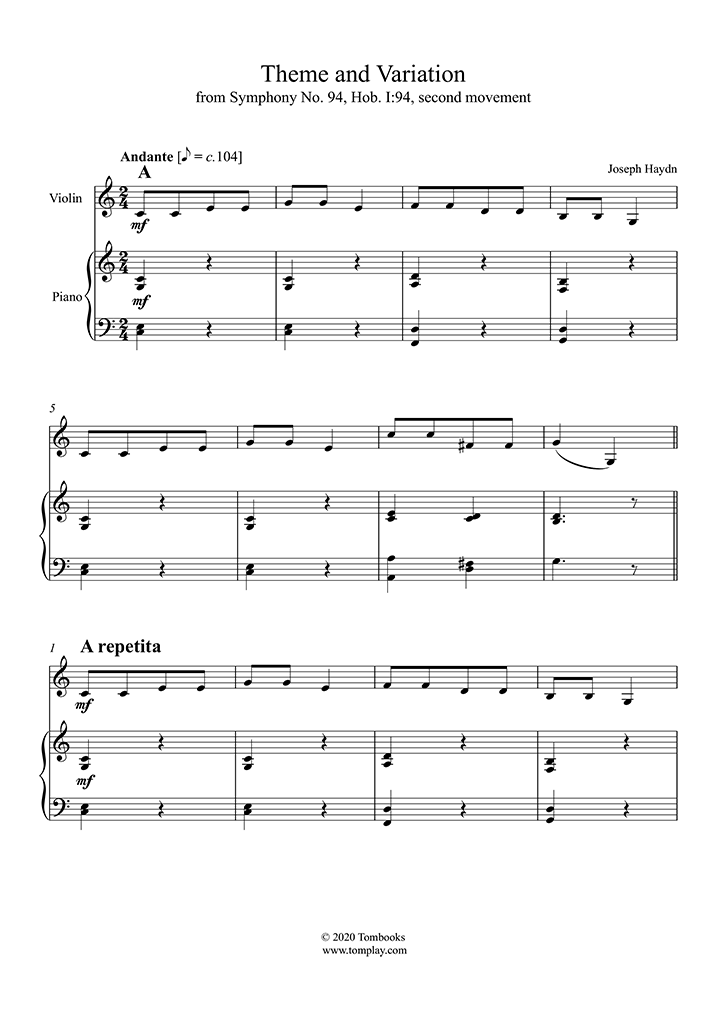

The masses were pieces of music used in the church and oratorios are large pieces of music written for an orchestra, choir, and solo singers.īy 1803, Haydn was physically unable to compose. He was composing vocal pieces like masses and oratorios during this time. Haydn spent the last years of his life in Vienna. (We will learn about their times together when we study Mozart and Beethoven in future lessons.)īesides often being called “Papa Haydn” like we learned in our last lesson, Franz Joseph Haydn and the Farewell Symphony… Haydn was also known as the “Father of the Symphony” and “Father of the String Quartet” because of his important work developing these forms. Wolfgang Amadeus Mozart and Ludwig van Beethoven. He was even a teacher to two extremely famous composers.

Haydn taught a lot of musicians throughout the years. He also composed “The Clock” that we used to learn about steady beats. Haydn’s Later YearsĪ lot of Haydn’s music contained jokes or special story lines. By the fourth and final movement the music is lively and energetic. The third movement is like a minuet or dance of the time. The second movement is at a gentle pace, but includes the famous surprise. It begins with a lively movement with several contrasting melodies. It has also proven to be really fun for my young students when I play the music one or two more times and let them pretend to be sleeping and snoring… and then startle awake.īesides this fun surprise in this piece of music, the four-movement symphony followed the structure that became a standard during the Classical Era of classical music. By the time you get to the bottom of the page, you will be at the last picture. Move your finger to the next picture every two notes until the last picture on each line. Play the video above again while following along with the music by putting your pointer finger on the pictures as you go.
#Haydn surprise symphony movement 2 pdf#
You can download my free PDF Surprise Symphony Listening Map. Let’s look at a music map of the Surprise Symphony. Whatever is the true story, this symphony earned the nickname Surprise Symphony after that first performance. It is said that the music was making it even easier to sleep until the fortissimo (very loud) note when the snoring man jumped to his feet. Would you wake up to that? I think I would. They then continued like nothing strange happened. All of a sudden they played a very loud note. The orchestra played softly and then even softer to lull the people to sleep. (Do not turn the volume up much, especially if using ear buds.) Let’s listen to it now to find out what he did. There was even a man in the front row who had started snoring on the evening of March 23, 1792, (the night of the first performance) before this movement even began, so Haydn came up with a plan to make them think twice about taking a nap during his music. Haydn was irritated by people always falling asleep and even snoring during concerts.

Not everyone agrees on the reason behind the change, but one story is the most famous… and the one that I like to believe. This symphony became famous quickly when Haydn was conducting at a concert and decided to change the dynamics of the second movement. One of my favorite Haydn symphonies is the “Surprise Symphony” (originally known as Symphony No. Haydn had composed twelve new symphonies including Symphony No. Critics and audiences alike loved what he was doing. If you missed the previous post about Haydn’s time as a Kapellmeister and the Farewell Symphony or about Haydn’s Early Years, check them out before you continue.ĭuring this time, Londoners showed up by the thousands to watch him conduct premieres of his new works. (A Kapellmeister is a leader or conductor of an orchestra of choir.) He earned the same amount of money in one year as he did all of his almost 20 years as a Kapellmeister combined. During this time he was composing music and experiencing life outside the royal court. He stayed in London for a year and a half and returned in 1794 for another year and a half. Franz Joseph Haydn arrived in London on New Year’s Day 1791.


 0 kommentar(er)
0 kommentar(er)
